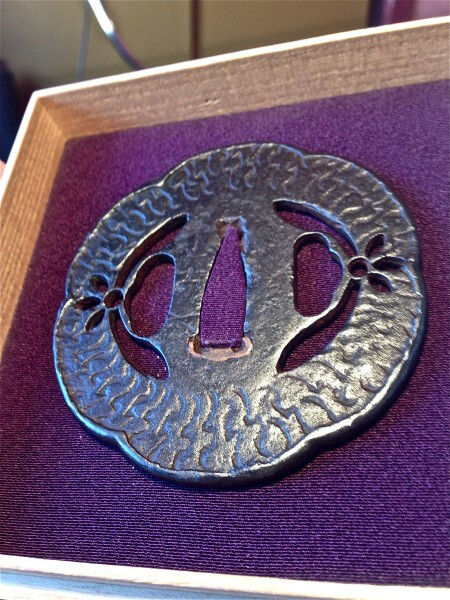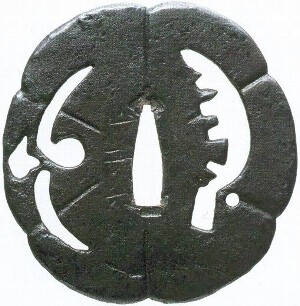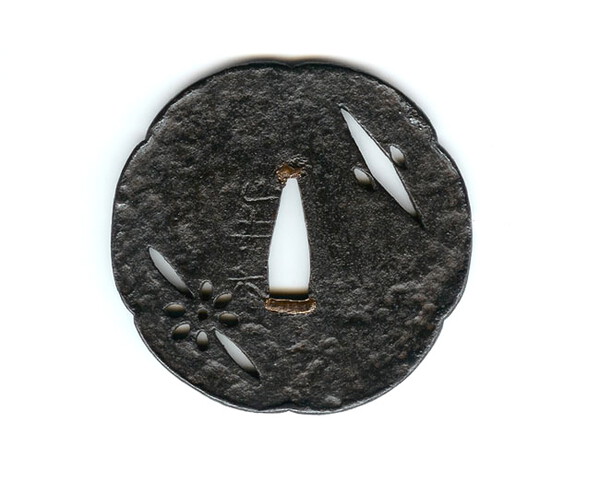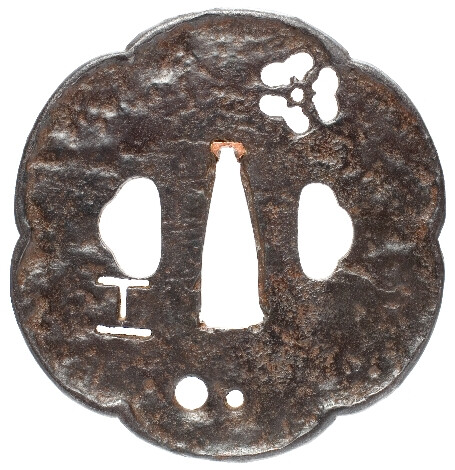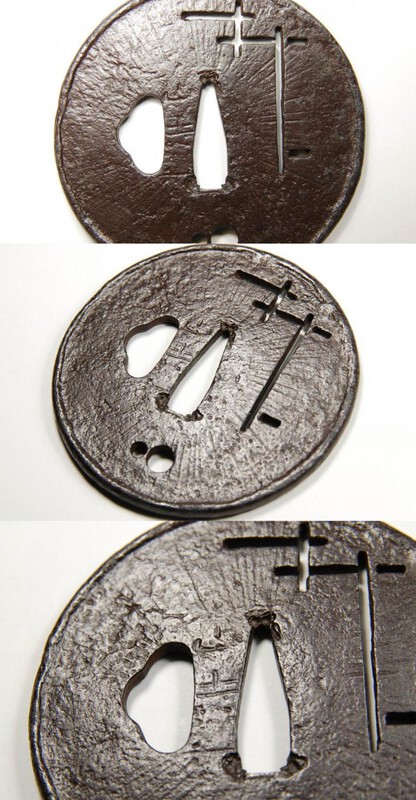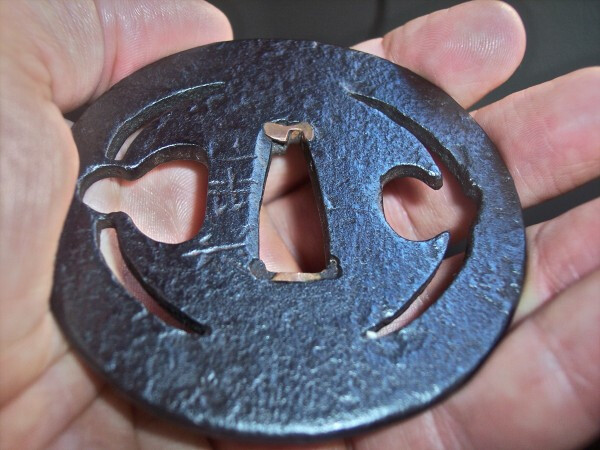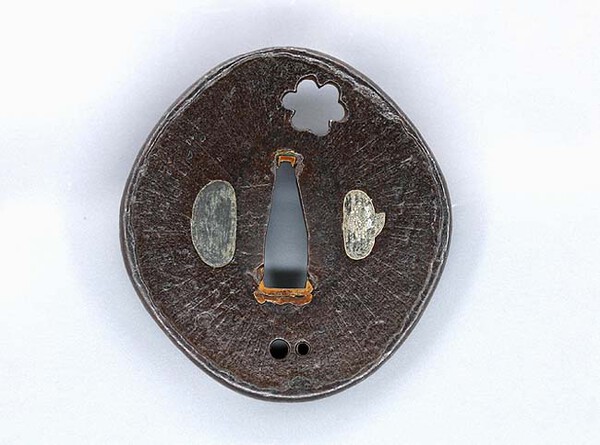-
Posts
962 -
Joined
-
Last visited
-
Days Won
4
Content Type
Profiles
Forums
Events
Store
Downloads
Gallery
Everything posted by Steve Waszak
-
I think I can answer for Evan, Sergei. The color photos are of a nidai Yamakichibei offered in an auction last year. I don't know the exact dimensions on this guard (I don't think Evan does either, since I sent him the photos originally... ). This tsuba has Tokubetsu Hozon papers and is, in my view, a masterwork. The color of this piece, in particular, is fantastic, being of that "yohkan" hue that is so highly prized (the oblique images, as usual, show the color of the guard best). The black and white photos are all taken from Owari to Mikawa No Tanko. Cheers, Steve
-
-
Thanks, Tim. Yes, all good titles there. I have all but the Rikyu book. Another publication I recommend in order to get a good introduction into Japanese aesthetic principles (some of which so prominently feature in Yamakichibei tsuba) is Donald Richie's A Tractate on Japanese Aesthetics.
-
Important to remember that in many cases, older literature (or brand new, for that matter) will contain and repeat errors, faulty and/or incomplete information, and questionable assumptions, premises, beliefs, reasoning, and conclusions. In order properly to pursue an analysis and assessment of a subject like this, it is crucial both to examine many examples of the tsuba in hand, as well as to educate oneself on larger historical and cultural contexts informing the creating of these pieces. Sharp skepticism is critical in this endeavor. Below are a few more photos of Yamakichibei guards. These include both "Meijin Shodai" (the last two examples) and Nidai pieces. Cheers, Steve
-
Sergei, The literature on Yamakichibei is scant, but one source you need to have is Okamoto's Owari To Mikawa no Tanko. I know Grey has had this title available in the past. There is an excellent translation, too. This book covers the tsuba smiths from Owari and Mikawa provinces (though curiously, the two early Nobuiye are omitted; perhaps Okamoto completed the book---an early 80s publication---before it was generally agreed that the two Nobuiye were Owari men). The section on Yamakichibei is the most in-depth and detailed in print I have yet seen. There are a few points Okamoto makes in his write-up that I don't quite agree with, or don't think are fully clear, but in the main, this is excellent material. As to the tsuba I posted the photo of, the mei reads "Yamakichibei," but it is a Yamasaka guard. How do I know? Lots of study and comparison of Saka tsuba with those of the Meijin Shodai. The literature states that Yamasaka Kichibei occassionally signed "Yamasaka Kichibei," but also signed just "Yamakichibei" at times. Yamasaka Kichibei is referred to as O-Shodai, while the "other shodai" is known as "Meijin Shodai." See studies of Kaneie for a similar situation as concerns shodai tsuba. In this particular piece, the workmanship and key details in the mei allow me to know it to be Saka work. You are correct, Sergei, in saying that there aren't a lot of reference photos of Yamasaka mei to be found. There are four Yamasaka tsuba illustrated in the Okamoto book. There are a couple of others in Nakamura's Tsuba Shusei, and the 2009 Dai Token Ichi catalogue not only has a good photo of a Yamasaka guard (complete with clearly legible mei), but also includes a photo of the Juyo Nidai Yamakichibei Otafuku-gata "blossom" tsuba that Sasano erroneously attributes to (Meijin) Shodai work in his "gold book." In the 2014 NBTHK Iron Tsuba Exhibition catalogue, there is a magnificent tsuba with a Yamakichibei mei that is a Yamasaka piece. This guard has many of the same features as the one I posted the photo of. Below is a photo of a Meijin Shodai sword guard. Cheers, Steve
-
Sergei, These tsuba you have presented here really have nothing to do with the actual Yamakichibei works of the Momoyama and earliest Edo Periods. They are "homage" pieces, if you will, but are only a hollow facsimile of the real thing. The inscription is "Yamakichi," as opposed to "Yamakichibei," and they always appear with those odd little holes (between 4 and 6) and carved lines in the vicinity of the hitsu-ana. Many of these were made in the 19th century, all with little variation, some 250 years after the actual Yamakichibei men were working. As for opinions on Yamakichibei tsuba overall, well, there is probably a range of viewpoints. Many here know mine, as I consider true, early Yamakichibei tsuba to be among the very best iron sword guards ever made. At their best, they are second to none, including Nobuiye and Kaneie. Their mastery of certain features/processes such as tsuchime, yakite, and tekkotsu, especially in combination, reached heights never to be surpassed, and rarely equaled, resulting in tsuba with great haki, or power. If one's taste is for sword guards with this sort of expressiveness, Yamakichibei works are at the top of the mountain. Of course, for many, such aesthetics hold less appeal. Yamakichibei tsuba are deeply connected with the aesthetics and culture of Buke Tea that was dominant in the Momoyama Period. The aesthetic principles informing cha no yu then---its ceramics and other articles, as well as the architecture and interior design---were of major importance to the leading figures (and thus their vassals) of the time. My belief is that one cannot properly appreciate or understand Yamakichibei guards unless one also studies the culture of Tea in the late-16th and early-17th centuries. If one cannot grasp what makes an Iga hanaire or Bizen mizushashi of that time a masterwork in ceramics, one may not be able to fully "get" Yamakichibei. There is much, MUCH more to be said about Yamakichibei, than can be adequately presented here. Perhaps a formal article is in order... Below is an early Yamakichibei tsuba (Yamasaka Kichibei). Cheers, Steve
-
Great tsuba, Tim. That second Hoan (the oval one) is wonderful, but the kikugata piece is spectacular. Best piece in this whole thread, in my opinion.
-
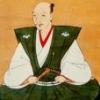
Seto Yaki Cha-Ire Tea Container In A Shifuku Bag
Steve Waszak replied to Robin's topic in Other Japanese Arts
Robin, Agreed: the lacquer repair is inspired. But I might suggest that the aesthetic principle here is more shibusa than wabi or sabi... -

Seto Yaki Cha-Ire Tea Container In A Shifuku Bag
Steve Waszak replied to Robin's topic in Other Japanese Arts
That is a beautiful cha-ire, Bernard. Really, really good. Cheers, Steve -
Some Japanese ceramics authorities argue that Shino is really properly understood to be "white Oribe" ware. When the origins of Oribe wares and Shino are considered, together with the clay types and the sensibilities reflected in certain aesthetic features, this view does make some sense... Cheers, Steve
-
Here is a period (Momoyama) kuro-Oribe chawan that sold at auction late last year. It is an obvious, no-doubter genuine Momoyama kuro-oribe piece. Relatively few such early pieces have survived to present day, so to find such a terrific example on offer will generate some pretty fierce competition. This chawan attracted hundreds of bids, and sold for over 3.4 million yen. I'd love to have had it, but as soon as I saw how magnificent it was, I knew it would skyrocket, and I'd have no chance... This is the sort of piece that comprises an excellent ceramics collection all by itself. Cheers, Steve
-
I'll look forward to seeing your published results, Jean. I am most curious to know how the yakite shitate effect could be created with neither acids nor heat...
-
Ken, When you say that this "was sold as a Hon Ami Koetsu related piece," what exactly is meant by "related"? In any event, I can with some confidence tell you that this piece was not made by Koetsu. Virtually anything made by him is of immense cultural importance, fame, and value. He is considered by many to be the single greatest artist in Japanese history. So it is unlikely that one of his works would slip under the radar. Besides this, though, the bowl itself displays nothing of Koetsu's sensibilities, style, or techniques in the making of chawan. So again, I wonder what the seller meant by "related." Cheers, Steve
-
Kanayama? It sure looks much more like late-Momoyama/early-Edo Owari sukashi to me. There isn't enough of a yakite effect to suggest Kanayama, I don't think. The bold symmetry and strong, visually-heavy rim, together with the size and thickness all point to Owari sukashi, and without a more pronounced yakite effect, I can't see this as Kanayama. There certainly has been some good discussion on what, exactly, yakite (shitate) actually refers to. Some say it describes actual heat-treating as a finishing process, while others claim this can't be the case due to the way the metal would "behave" in such a process (i.e. the result wouldn't look like what we see in classic Kanayama tsuba). Instead, some argue, yakite refers to a particular effect (a "melty" finish) that is actually gained via the application of acids/chemicals to the surface of the metal. Not being a metallurgist, and not having been there at the forges of these smiths those 400+ years ago, I'm not entirely sure what to believe. Certainly we have seen examples of techniques in forging and/or finishing (in blades, say) that seem to have been lost to time, as later and modern-day smiths appear unable to recreate the effects those techniques would realize in the steel. So the possibility that tsubako of old may have had some way of manipulating heat (along with acids?) to achieve the yakite effect appears not entirely invalid, at least to me.
-
Curran, Oh yes, THAT Yamakichibei is burned into my memory! A brilliant tsuba. Same guy got that as won this Hikozo auction, yes. He's had many other successes, too. That Yamakichibei went for over a million yen, by the way... Stephen, yes, it would be good to know who this guy is, though as you say, that won't help us outbid him at auction!
-
I expected, as I suspect Pete did, too, that this guy would walk away with this tsuba in the end. Seems like these days, for pieces of superior quality/importance like this one, he nearly always does. But I am surprised by the low winning bid: only about half of what I'd have thought. Pete's supposition that other bidders give up when they see that this guy has entered the fray is probably accurate, and could explain why this didn't go higher. Quite a collection he is putting together.
-
Edit accomplished.
-
Ford, Those questions you ask at the end of your recent posts are all good ones, and thought-provoking. Each deserves its own thread, though. Just a quick comment about evidence. You ask whether there is any "actual historical evidence" supporting some of the "accepted wisdom" out there. Your query raises interesting further questions regarding what counts as evidence. I think from your post that you are referring to concrete, incontrovertible evidence. I wonder how often we really do have this kind/degree of evidence supporting what we know/"know" about nihonto and tosogu. You zero in on a handful of examples, which are all good, but couldn't this list be expanded almost infinitely? Epistemological issues and questions are teeming in our studies in nihonto and tosogu, it seems to me. This is due to many factors, but at least two stand out. One, of course, is simple historical distance: when we are talking about artists, smiths, and objects dating back multiple centuries, the potential for murkiness in knowledge acquisition is high. Added to this is the obfuscation created via invented genealogies, iemoto-ism, perpetuation of myth and (other) romantic constructs, reliance on tradition, etc..., and what we're left with is or should be a lack of confidence in what we (think we) know about swords, tosogu, and smiths/artists. Believe me, I'm a huge fan of actual historical, concrete evidence when we have it. But what to do, then, when we don't? I think what many of us tend to rely on---if traditional sources of knowledge are looked upon with healthy skepticism---is circumstantial evidence combined with sharp inductive reasoning. We may be (usually are) forced here to rely on likelihoods and nothing more, since anything more would have to come out of our having "actual historical evidence." Some likelihoods are greater than others, of course, depending again on the strength of specific circumstantial evidence as well as on one's powers of inductive reasoning. In the end, we are left to make the best arguments we can for the conclusions we draw (even if with some tentativeness or qualification), as those highly desirable incontrovertible historical facts we seek are so often absent, and will likely remain so.
-
I wouldn't be surprised in the slightest to see this zoom past the million-yen mark... And that wouldn't be an outrageous price for it, not even close.
-
Really fascinating, Peter. Thanks for posting this. He was definitely a complicated man. I did a lot of writing on Mishima in grad school: there is much more to him than may at first meet the eye.
-

This Is Well Worth Reading:
Steve Waszak replied to Pete Klein's topic in General Nihonto Related Discussion
I do wonder---speaking now of early iron fittings---how many of such works could have survived the centuries enduring Japan's climate without having been "attended to" across their long lives. Is it really possible for an early-Edo (or earlier) iron tsuba to have made it across 400 years never having been cleaned, oiled, waxed, re-patinated, etc...? I suppose it's possible, but it must be a relatively rare occurrence, no? I can't help but wonder what the de-rigueur care of iron fittings was in pre-Modern Japan. How was a 16th-century ko-Katchushi sword guard cared for/attended to 100 years after its production? 200 years? 300 years? I don't know that we can really ever know such things, especially as philosophies, practices and customs may have changed over the course of time and/or been different from region to region. Here's a link to an interesting discussion on the matter of restoration and conservation of such objects: http://www.militaria.co.za/nmb/topic/21171-restoration-of-tosogu-nihonto-etc/?hl=%2Brestoration+%2Btosogu. In the end, whatever our particular subjective philosophy may be concerning suitable approaches to conservation and/or restoration of fittings, cultural, political and economic factors will always complicate matters to the point of threatening any clarity we might have on the issue in an ideal world. -
This is a yon-ji mei, correct? I think I see the first one as "Yama."
-
Hi Evan, Lids on mizusashi are a rather interesting sub-topic. As is probably not surprising given the many intricate aesthetic considerations attaching to anything Tea, the type of lid on a water jar carries different connotations of formality and status. While lacquered lids are considered more formal, ceramic lids hold a higher status, despite their appearing less "polished." I believe that many lacquered lids are original to the piece. High-fired ceramic stoneware is not especially likely to break, and even if a lid were to be damaged, the art of kintsugi would, perhaps, allow for it to continue to be used. The contrast between the earthy strength of Bizen, Shigaraki, and Iga vessels, on the one hand, and the smooth black, lustrous polish of the lid used on a mizusashi, on the other hand, I'm sure expressed an aesthetic that had high value in Tea Culture sensibilities. Same would go for the ivory lids on tea caddies, though here, the contrast would likely be much more subtle, since caddies themselves were usually less "crudely wrought" than works coming from Iga, Bizen, or Shigaraki kilns. Cheers, Steve
-
A very nice modern piece here, Evan. Thanks for posting this (and the review of Bizen firing practices... ). Here is a ko-Bizen "pail-type" Mizusashi I managed to acquire earlier this year. The colors and textures achieved in the firing process on this piece are really excellent. Late Momoyama to earliest Edo. Cheers, Steve
-
Hi John, Thanks for your post here. All interesting stuff. My particular interest in this topic concerns Naomasa's dates, though, more than the typing or categorizing of Onin guards. I remain dubious about this tsuba maker's working dates being any earlier than late-Momoyama. The tsuba you reference dated to 1533 is certainly eyebrow-raising: I have to think there is an error here somewhere (as you have suggested), or simply represents an attempt to deceive. The article on Onin tsuba you provide the link to notes that Naomasa's "name is found, sometimes genuine, sometimes forged..." Given the esteem Naomasa's work was apparently held in, the notion that his signature (including dates?) could have been added later to mumei pieces isn't much of a stretch. So I don't find the tsuba dated to 1575 necessarily very compelling as hard and fast evidence, either. Another consideration here concerns the cultural and aesthetic climate of the time. Compared to the relatively austere sensibilities of Muromachi years, the Momoyama Period was far more flamboyant and alive with experiment and exuberance of expression. Yoshiro tsuba fit this context much better than they would a 1550s or 1560s dating, in my view. Then there is Ford's very intriguing work in researching brass availability and use in 16th-17th century Japan (many thanks for this post, Ford! ). Putting all of this together, it is hard for me to see Naomasa's working period beginning any earlier than the 1580s at the very earliest, with the 1590s more likely, assuming the Hideyoshi quote is legitimate. If the Hideyoshi quote is apocryphal, then I could see Naomasa's working period being even later by a decade or two. Cheers, Steve


